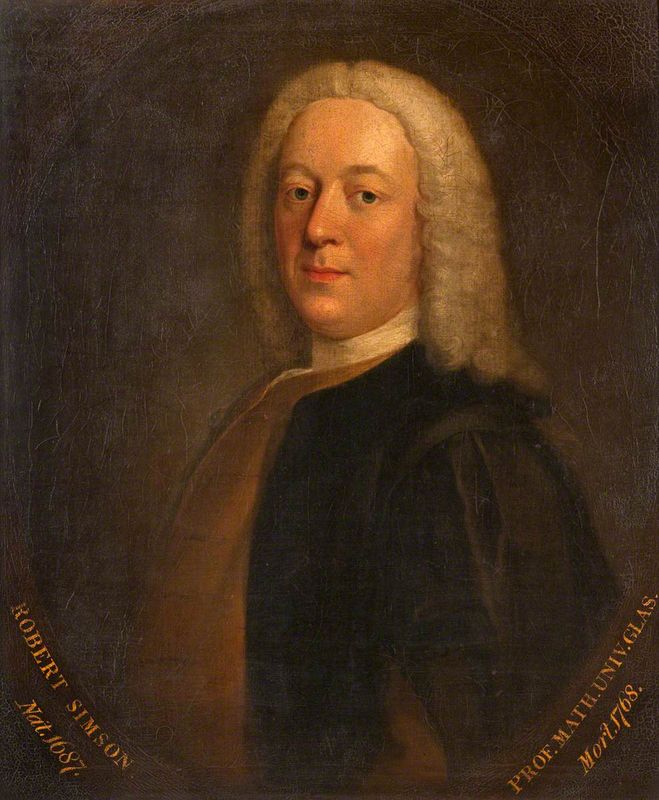Robert Simson (1687–1768)
Robert Simson, M.D., Professor of Mathematics at the University of Glasgow (1712–1761) and Clerk of Senate (1728–1761)
Dictionary of National Biography (1885–1900)
SIMSON, ROBERT (1687–1768), mathematician, born on 14 Oct. 1687, was the eldest son of John Simson, a Glasgow merchant, of Kirktonhall, West Kilbride, Ayrshire, by his wife Agnes, daughter of Patrick Simson, minister of Renfrew. Thomas Simson [q. v.] was a younger brother. Robert was admitted to Glasgow University on 3 March 1701–2, graduating M.A. on 16 Nov. 1711 (Munimenta Univ. Glasguen. Maitland Club, iii. 46, 173). He studied under his maternal uncle, John Simson [q. v.], professor of divinity, and distinguished himself by his classical attainments and knowledge of botany. His father intended that he should become a minister, but in the latter part of his university career he turned his attention to mathematics, and after a year's study in London he was elected professor of mathematics at Glasgow University, on 11 March 1711–12, on the resignation of Robert Sinclare (ib. ii. 400–2).
While in London Simson made the acquaintance of several eminent mathematicians, among them Edmund Halley [q. v.] Halley's influence tended to confirm him in his predilection for the works of the Greek geometricians, for the study of which his classical learning fitted him. He first directed his attention to Euclid's porisms, which are only known from the short account in the ‘Collectiones Mathematicæ’ of Pappus of Alexandria. Although Pierre de Fermat claimed to have restored Euclid's work, and Halley had edited the Greek text of the preface to the seventh book of Pappus, Simson was the first to throw real light on the matter. In a paper communicated in 1723 to the Royal Society by James Jurin [q. v.], Simson explained two general propositions in which Pappus summed up several of the porisms. He carried his investigations further in a treatise entitled ‘De Porismatibus Tractatus; quo doctrinam porismatum satis explicatam, et in posterum ab oblivione tutam fore sperat auctor.’ This was published in 1776 among Simson's posthumous works and was supplemented in a memoir by John Playfair [q. v.] (Trans. Royal Soc. Edinburgh, 1794; Heiberg, Litterargeschichtliche Studien über Euklid, 1882, p. 56).
In 1735 Simson published ‘Sectionum Conicarum Libri V’ (Edinburgh, 4to), which he partly intended as an introduction to the treatise by Apollonius of Perga on the subject. Simson had an aversion to the algebraical treatment of ‘conics’ that was prevalent, and in his own work returned to ‘the purer model of antiquity,’ deducing the properties of the various curves without the aid of symbols. An enlarged edition appeared in 1750.
In 1738 he completed the restoration of the ‘Loci Plani’ of Apollonius, a task already attempted by Fermat before 1629 (Œuvres de Fermat, 1891, i. 3–51, ii. 105), and by Francis Schooten in 1657 (Exercitationes Mathemat.) Simson published his conclusions in 1749 in a work entitled ‘Apollonii Pergæi Locorum Planorum libri II, restituti a R. Simson’ (Glasgow, 4to), which was translated into German in 1822 by W. A. Diesterweg (Mayence, 8vo).
Simson next occupied himself with the restoration of the ‘Sectio Determinata’ of Apollonius, which had already been imperfectly accomplished by Alexander Anderson [q. v.] in 1612, and by Willebrodus Snellius in 1634 (Pierre Herigone, Cursus Mathematicus, tome i.). The results of his labours were published among his posthumous works. Simson's researches among the mathematical fragments of classical antiquity, although his restorations were far from complete, and in many cases were more or less conjectural, notably elucidated the obscurities of ancient geometry.
In 1746 the university of St. Andrews conferred on him the honorary degree of M.D., and in 1756 he issued an edition of the ‘Elements of Euclid’ (Glasgow, 4to; 24th ed. 1834), to which he added the ‘Data’ in 1762. His edition has always held a high character for precision and accuracy, and has formed the basis of most modern textbooks, but in some instances his reverence for antiquity has asserted itself at the expense of his critical discernment. Refusing to admit any imperfection in Euclid, he imputed all shortcomings to his editors and copyists.
In 1761 he retired from the active duties of his chair, and employed his leisure chiefly in correcting his mathematical works. He died at Glasgow, unmarried, on 1 Oct. 1768, and was buried in the Blackfriars burial-ground.
A posthumous edition of Simson's unpublished works was issued at Glasgow in 1776, under the superintendence of James Clow, professor of philosophy at Glasgow, and at the expense of Philip Stanhope, second earl Stanhope. Besides the treatises mentioned, it contained two short tracts entitled ‘De Logarithmis liber’ and ‘De Limitibus Quantitatum et Rationum, Fragmentum,’ which have since been reprinted by Francis Maseres [q. v.] in his ‘Scriptores Logarithmici.’ A treatise on the ‘Elements of Plane Trignometry’ was published with the later editions of Simson's ‘Elements of Euclid,’ and also separately at Dublin in 1841. His library and all his manuscripts, including an incomplete edition of Pappus, and eighteen volumes on mathematical subjects, entitled ‘Adversaria,’ were presented to the university library at Glasgow.
Simson's portrait hangs in the college hall at Glasgow, and an engraving from it is prefixed to Trail's account of his life and writings.
[Trail's Account of the Life and Writings of Robert Simson, 1812; Encycl. Britannica, 8th ed. xx. 298–302, 9th ed. xxii. 88; English Cycl. Biography, v. 519; Anderson's Scottish Nation, iii. 455; Chambers's Eminent Scotsmen, iii. 350; Chalmers's Biogr. Dict. 1816, xxviii. 21; Hutton's Philosophical and Mathematical Dictionary, 1815; Bromley's Catalogue of Portraits, p. 394; Notes and Queries, I. i. 133, III. ii. 480, 499; New Statistical Account of Scotland, v. 252; Ball's Short History of Mathematics, p. 55.]
E. I. C.
